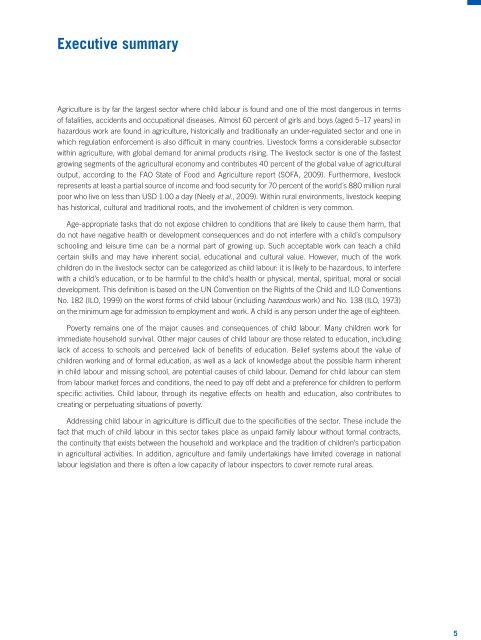Children’s work in the livestock sector: Herding and beyond
Children’s work in the livestock sector: Herding and beyond
Children’s work in the livestock sector: Herding and beyond
You also want an ePaper? Increase the reach of your titles
YUMPU automatically turns print PDFs into web optimized ePapers that Google loves.
Executive summary<br />
Agriculture is by far <strong>the</strong> largest <strong>sector</strong> where child labour is found <strong>and</strong> one of <strong>the</strong> most dangerous <strong>in</strong> terms<br />
of fatalities, accidents <strong>and</strong> occupational diseases. Almost 60 percent of girls <strong>and</strong> boys (aged 5–17 years) <strong>in</strong><br />
hazardous <strong>work</strong> are found <strong>in</strong> agriculture, historically <strong>and</strong> traditionally an under-regulated <strong>sector</strong> <strong>and</strong> one <strong>in</strong><br />
which regulation enforcement is also difficult <strong>in</strong> many countries. Livestock forms a considerable sub<strong>sector</strong><br />
with<strong>in</strong> agriculture, with global dem<strong>and</strong> for animal products ris<strong>in</strong>g. The <strong>livestock</strong> <strong>sector</strong> is one of <strong>the</strong> fastest<br />
grow<strong>in</strong>g segments of <strong>the</strong> agricultural economy <strong>and</strong> contributes 40 percent of <strong>the</strong> global value of agricultural<br />
output, accord<strong>in</strong>g to <strong>the</strong> FAO State of Food <strong>and</strong> Agriculture report (SOFA, 2009). Fur<strong>the</strong>rmore, <strong>livestock</strong><br />
represents at least a partial source of <strong>in</strong>come <strong>and</strong> food security for 70 percent of <strong>the</strong> world´s 880 million rural<br />
poor who live on less than USD 1.00 a day (Neely et al., 2009). With<strong>in</strong> rural environments, <strong>livestock</strong> keep<strong>in</strong>g<br />
has historical, cultural <strong>and</strong> traditional roots, <strong>and</strong> <strong>the</strong> <strong>in</strong>volvement of children is very common.<br />
Age-appropriate tasks that do not expose children to conditions that are likely to cause <strong>the</strong>m harm, that<br />
do not have negative health or development consequences <strong>and</strong> do not <strong>in</strong>terfere with a child´s compulsory<br />
school<strong>in</strong>g <strong>and</strong> leisure time can be a normal part of grow<strong>in</strong>g up. Such acceptable <strong>work</strong> can teach a child<br />
certa<strong>in</strong> skills <strong>and</strong> may have <strong>in</strong>herent social, educational <strong>and</strong> cultural value. However, much of <strong>the</strong> <strong>work</strong><br />
children do <strong>in</strong> <strong>the</strong> <strong>livestock</strong> <strong>sector</strong> can be categorized as child labour: it is likely to be hazardous, to <strong>in</strong>terfere<br />
with a child’s education, or to be harmful to <strong>the</strong> child’s health or physical, mental, spiritual, moral or social<br />
development. This def<strong>in</strong>ition is based on <strong>the</strong> UN Convention on <strong>the</strong> Rights of <strong>the</strong> Child <strong>and</strong> ILO Conventions<br />
No. 182 (ILO, 1999) on <strong>the</strong> worst forms of child labour (<strong>in</strong>clud<strong>in</strong>g hazardous <strong>work</strong>) <strong>and</strong> No. 138 (ILO, 1973)<br />
on <strong>the</strong> m<strong>in</strong>imum age for admission to employment <strong>and</strong> <strong>work</strong>. A child is any person under <strong>the</strong> age of eighteen.<br />
Poverty rema<strong>in</strong>s one of <strong>the</strong> major causes <strong>and</strong> consequences of child labour. Many children <strong>work</strong> for<br />
immediate household survival. O<strong>the</strong>r major causes of child labour are those related to education, <strong>in</strong>clud<strong>in</strong>g<br />
lack of access to schools <strong>and</strong> perceived lack of benefits of education. Belief systems about <strong>the</strong> value of<br />
children <strong>work</strong><strong>in</strong>g <strong>and</strong> of formal education, as well as a lack of knowledge about <strong>the</strong> possible harm <strong>in</strong>herent<br />
<strong>in</strong> child labour <strong>and</strong> miss<strong>in</strong>g school, are potential causes of child labour. Dem<strong>and</strong> for child labour can stem<br />
from labour market forces <strong>and</strong> conditions, <strong>the</strong> need to pay off debt <strong>and</strong> a preference for children to perform<br />
specific activities. Child labour, through its negative effects on health <strong>and</strong> education, also contributes to<br />
creat<strong>in</strong>g or perpetuat<strong>in</strong>g situations of poverty.<br />
Address<strong>in</strong>g child labour <strong>in</strong> agriculture is difficult due to <strong>the</strong> specificities of <strong>the</strong> <strong>sector</strong>. These <strong>in</strong>clude <strong>the</strong><br />
fact that much of child labour <strong>in</strong> this <strong>sector</strong> takes place as unpaid family labour without formal contracts,<br />
<strong>the</strong> cont<strong>in</strong>uity that exists between <strong>the</strong> household <strong>and</strong> <strong>work</strong>place <strong>and</strong> <strong>the</strong> tradition of children’s participation<br />
<strong>in</strong> agricultural activities. In addition, agriculture <strong>and</strong> family undertak<strong>in</strong>gs have limited coverage <strong>in</strong> national<br />
labour legislation <strong>and</strong> <strong>the</strong>re is often a low capacity of labour <strong>in</strong>spectors to cover remote rural areas.<br />
5


